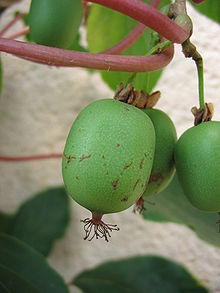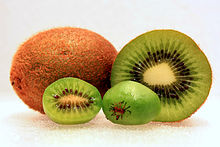- Actinidia arguta
-
Hardy Kiwi 
Scientific classification Kingdom: Plantae (unranked): Angiosperms (unranked): Eudicots (unranked): Asterids Order: Ericales Family: Actinidiaceae Genus: Actinidia Species: A. arguta Binomial name Actinidia arguta
(Siebold & Zucc.) Planch. ex Miq.Hardy Kiwifruit, fresh, raw[1] Nutritional value per 100 g (3.5 oz) Energy 322 kJ (77 kcal) Carbohydrates 18 g - Sugars 7.6 g - Dietary fiber 3 g Fat 0.6 g Protein 1.2 g Vitamin C 54 mg (65%) Sodium 6 mg (0%) Percentages are relative to US recommendations for adults. Actinidia arguta (hardy kiwi) is a perennial vine native to Korea, Northern China, and Russian Siberia, producing a small fruit resembling the kiwifruit.[2]
The fruit are referred to as Hardy kiwifruit, kiwi berry, arctic kiwi, baby kiwi, dessert kiwi or cocktail kiwi and are edible, berry or grape-sized fruit similar to kiwifruit in taste and appearance, but are green or purple with smooth skin. Often sweeter than the kiwifruit, hardy kiwifruit can be eaten whole and need not be peeled. Thin-walled, its exterior is smooth and leathery.
Cultivation
The fast-growing, climbing vine is very hardy (hence the name hardy kiwi), and is capable of surviving slow temperature drops to -34°C (-30°F), although young shoots can be vulnerable to frost in the spring.[3] The vines need a frost-free growing season of about 150 days, but are not damaged by late freezes, provided that temperature changes are sufficiently gradual to allow plants to acclimate. Indeed, a period of winter chill is necessary for successful cultivation. However, rapid freezes will kill off buds and split vines. The vines can also be grown in low-chill areas.[2]
In western Massachusetts and other isolated sites in New England, the vine has become quite invasive in forested areas. Forests provide a natural trellis for the vine to cling to as it grows vertically towards the sunlight. The weight of the winter snow on top of the hardy kiwi vine causes trees to collapse and fall. The vine spreads to new trees, causing them to collapse, creating a landscape which resembles an amphitheatre. Mammals and birds are able to spread hardy kiwi seeds to unwanted areas. The impact of hardy kiwi on New England's hardwood forests is unknown, as this is a newly discovered invasion.
While hardy kiwi may be grown directly from seeds (germination time is approximately one month), it is also possible to propagate from cuttings. Hardy kiwi cuttings may be grafted directly onto established kiwifruit rootstock, or rooted themselves. In domestic cultivation, a trellis may be used to encourage horizontal growth for easy maintenance and harvesting; however, vines grow extremely quickly and require a strong trellis for support. Each vine can grow up to 20 feet in a single season, given ideal growing conditions.[4] For commercial planting, placement is important: plants can tolerate partial shade but yields will be optimized with full sunlight. Hardy kiwi vines consume large volumes of water; therefore, they are usually grown in well-drained acidic soils to prevent root rot.[2]
For vines to bear fruit, both male and female plants must be present to enable pollination. A male pollinator can enable six female producers to fruit.[3] Flowering typically occurs in May (in the Northern Hemisphere) starting in the third year of growth.[5] If flowers become frost-burned, however, no fruit production will occur during the remainder of the year.[3] An autumn harvest is standard among all varieties; within this, actual harvest times are highly dependent on local climate and the specific cultivar grown.[2] Each individual vine can produce up to 100 pounds of fruit per year, but average annual yield is approximately 50 pounds per vine.[3] Both fruit size and total yield are highly cultivar-dependent. Fruits left to ripen on the vine contain a 18 to 25 percent sugar content at time of harvest.[3]
Hardy kiwi vines are vulnerable to several botanical diseases, including phytophthora crown and root rot (the most serious problem), botrytis rot, and sclerotinia blight. Vines are also vulnerable to insect infestations, including root knot nematodes, two-spotted spider mites, leaf rollers, thrips, and Japanese beetles.[3] Cats can also pose a problem, as they are attracted to a catnip-like smell that is produced by the hardy kiwi vines. Cats have been known to destroy vines and dig up roots in search of the source of the scent.[2]
Attempts to commercialize the fruit have been historically unsuccessful due to its short shelf-life and sporadic tendencies to ripen. However, attempts are being made to bring the fruit to greater bear, and commercial production initiatives are underway on a small scale in South America, New Zealand, Europe, and the USA (in Oregon, Washington, and northern New England).[4]
Botanical history and taxonomy
Actinidia arguta was first described by Philipp Franz von Siebold and Joseph Gerhard Zuccarini in 1843 as Trochostigma argutum.[6] It was then moved to the genus Actinidia in 1867 by Friedrich Anton Wilhelm Miquel after the invalidly published suggestion by Jules Émile Planchon to move the species.[7]
The species consists of three varieties:[7]
- Actinidia arguta var. arguta (autonym)
- Actinidia arguta var. giraldii (Diels) Vorosch.
- Actinidia arguta var. hypoleuca (Nakai) Kitam.
Actinidia arguta var. giraldii was originally described by Ludwig Diels at the species rank (Actinidia giraldii) in 1905,[8] but was later reduced to a variety of A. arguta in 1972 by Vladimir Nikolaevich Voroschilov.[9] Actinidia arguta var. hypoleuca was originally described at the species rank (Actinidia hypoleuca) by Takenoshin Nakai in 1904,[10] but reduced to a variety of A. arguta in 1980 by Siro Kitamura.[11]
Actinidia arguta had been placed in section Leiocarpae and series Lamellatae, but this current infrageneric classification is unsupported. A 2002 study of the nuclear DNA internal transcribed spacer sequence and the plastid matK gene sequence for cladistic analysis revealed the current circumscription of the sections to be polyphyletic, with A. arguta forming a clade with A. melanandra near the base of the phylogenetic tree.[7][12]
References
- ^ Nutritional Value NZ KiwiBerry Growers Incorporated.
- ^ a b c d e Hardy Kiwifruit Fruit Facts. 1996, California Rare Fruit Growers, Inc.
- ^ a b c d e f Hardy Kiwi Hardy Kiwi. Dec. 16, 2008, Penn State College of Agricultural Sciences.
- ^ a b Hardy Kiwi Nan Sterman, National Gardening Association.
- ^ Kiwifruit and Hardy Kiwi Kiwifruit and Hardy Kiwi HYG-1426-93. John Strang & Richard C. Funt, Ohio State University.
- ^ "Trochostigma argutum Siebold & Zucc.". Germplasm Resources Information Network (GRIN) online database. http://www.ars-grin.gov/cgi-bin/npgs/html/taxon.pl?40670. Retrieved 26 March 2010.
- ^ a b c "Actinidia arguta (Siebold & Zucc.) Planch. ex Miq.". Germplasm Resources Information Network (GRIN) online database. http://www.ars-grin.gov/cgi-bin/npgs/html/taxon.pl?1389. Retrieved 26 March 2010.
- ^ "Actinidia giraldii Diels". Germplasm Resources Information Network (GRIN) online database. http://www.ars-grin.gov/cgi-bin/npgs/html/taxon.pl?419962. Retrieved 26 March 2010.
- ^ "Actinidia arguta (Siebold & Zucc.) Planch. ex Miq. var. giraldii (Diels) Vorosch.". Germplasm Resources Information Network (GRIN) online database. http://www.ars-grin.gov/cgi-bin/npgs/html/taxon.pl?419961. Retrieved 26 March 2010.
- ^ "Actinidia hypoleuca Nakai". Germplasm Resources Information Network (GRIN) online database. http://www.ars-grin.gov/cgi-bin/npgs/html/taxon.pl?420050. Retrieved 26 March 2010.
- ^ "Actinidia arguta (Siebold & Zucc.) Planch. ex Miq. var. hypoleuca (Nakai) Kitam.". Germplasm Resources Information Network (GRIN) online database. http://www.ars-grin.gov/cgi-bin/npgs/html/taxon.pl?459544. Retrieved 26 March 2010.
- ^ Li, J., H. Huang, and T. Sang. 2002. Molecular phylogeny and infrageneric classification of Actinidia (Actinidiaceae). Systematic Botany, 27(2): 408-415.
Wikimedia Foundation. 2010.


